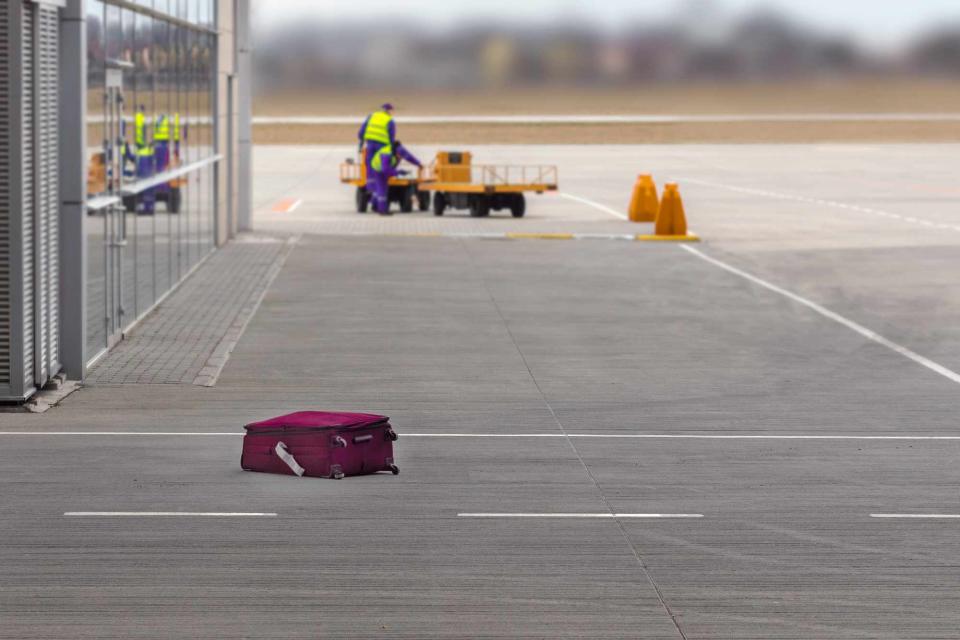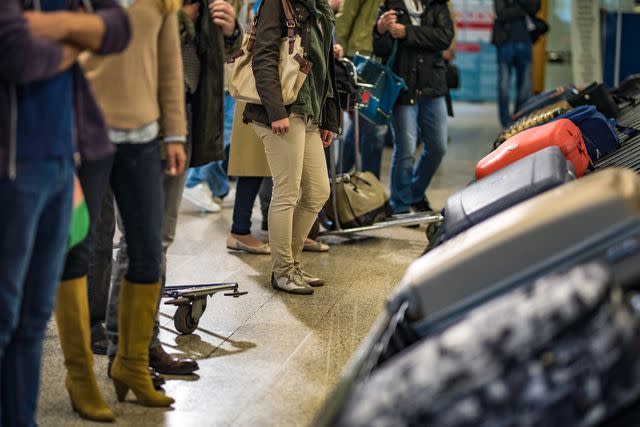What to Do When an Airline Loses Your Luggage
Here are seven steps to follow if an airline loses your luggage.

Serhii Ivashchuk/Getty Images
It’s every traveler's worst nightmare — you show up to the baggage belt and wait for your suitcase to arrive. As each person picks up their luggage, you have the sinking feeling that yours won’t appear. Once all bags are off the plane and yours is nowhere to be found, what should you do? I spoke with the Department of Transportation (DOT) to develop this guide on what to do when an airline loses your luggage.
Unfortunately, this is a relatively common occurrence. My suitcase has been lost before, and countless others have had the same experience. Although the numbers are trending lower than the same time last year, hundreds of thousands of bags still get mishandled in transit for one reason or another. The most important thing to do if your suitcase gets lost is to stay calm. More often than not, it will be found and returned to you. If it doesn’t, you can receive compensation for your lost items up to a maximum liability determined by the DOT. Here are the steps you need to take when an airline loses your luggage.
7 Steps to Take When an Airline Loses Your Luggage
1. Confirm your luggage is actually lost.

vm/Getty Images
“Generally, when a checked bag does not arrive at its destination, airlines are responsible for locating the bag,” says the DOT. “Airlines have tracking systems in place to try to identify the bag’s location. Some airlines now offer applications for cell phones, tablets, and other electronic devices, which provide passengers with data on the location of their baggage.”
I’ve waited over an hour at the carousel to receive my bag before, so don’t automatically assume it’s lost. Sometimes, it just takes a long time due to staffing issues or the airport's size. It might also end up at a different carousel than you thought. When this happens, having an AirTag or other tracking device in your suitcase is helpful so you can quickly determine the location. If you’ve waited and checked other carousels and still can’t find your bag, you can talk to the airline.
2. File a missing baggage report.
You will need to locate the baggage desk for the airline that operated your final flight and let them know that your bag is missing. The baggage desk is typically beside the carousels, so it should be easy to find. Show the agent the bag tag you received when you checked your bag. They might be able to locate your bag in the system. If not, you’ll need to fill out a missing baggage report.
When you fill out your missing baggage report, you’ll be asked about any identifying information about your bag: the brand, color, size, any identifying marks, approximate weight, etc. You’ll also need to put your contact information, local address, and information about your flight. The more identifying information, the better. So, if you don’t already, make sure you have something notable on your bag to help identify it, whether that’s a brightly colored ribbon, stickers, or a strong bag tag.
“Passengers should file a baggage claim with their airline as soon as possible and stay in close communication with the airline after filing a claim and during the baggage location process,” explains the DOT. Make sure you keep your case reference number so you can look up the status of your case online after you leave the airport.
3. Determine what the airline will cover.
Most airlines have policies for lost or delayed baggage. This will vary between airlines, so ask the representative what will be covered for essential expenses until they locate your bag. They might not proactively give you this information, so it’s crucial to ask. (I didn’t realize the airline had policies for expense reimbursements on delayed baggage, so I paid out of pocket for my essentials when my bag was lost.) Once you know what they will cover, you can go shopping. Keep all of your receipts so you can submit the request for reimbursement. This isn’t the time to go on a full shopping spree, but you can typically buy things you deem essential while waiting for your luggage.
4. Understand the difference between lost and delayed baggage.
Another lesson I had to learn the hard way is that there’s a difference between lost baggage and delayed baggage. “Most airlines will declare a bag lost between five and 14 days after the flight, but this can vary from one airline to another,” says the DOT. “Once an airline determines that a bag is lost, the airline is responsible for compensating the passenger for the bag’s contents - subject to depreciation and maximum liability limits.”
"Delayed baggage" means that it has been found and will be delivered to you within a few days. If your bag is delayed, make sure they drop it off at your local address. You shouldn’t have to go back to the airport or pay for it to be delivered. "Lost baggage" means it’s genuinely lost and cannot be found.
Related: You Might Be Entitled to Compensation If Your Bag Is Delayed — What to Know
5. Contact your credit card company.
If you booked your flight using a travel credit card, you should contact your credit card issuer as soon as possible. Several credit cards, like the Chase Sapphire Reserve, offer baggage delay insurance, which might cover up to $100 a day for five days if your suitcase has been delayed. Understanding the difference between lost and delayed baggage is crucial here.
My airline-branded credit card covered lost baggage, so I went out and spent a few hundred dollars on clothes and toiletries to cover me for the first few days. Once my bag was found and returned to me, it was considered delayed baggage, which the card doesn’t cover. This meant I was on the hook for the money I spent and would not get reimbursed. Although they sound very similar, and my bag certainly felt lost before I got it back, this distinction meant I lost hundreds of dollars.
6. Keep tracking your bag.
This goes without saying, but keep an eye on your bag and the status of your claim by using the reference number given to you when you filled out the missing baggage report. Stay in constant communication with the airline to receive the most up-to-date information about your suitcase. Ideally, it’s quickly found and returned to you, but if not, you need to know the next steps to receive a refund.
If your bag is considered lost and you are given a reimbursement, the maximums are set by the DOT. “For domestic flights, DOT regulation allows airlines to limit their liability for a lost, damaged, or delayed bag to $3,800,” explains the DOT. For international flights, that number goes down to about $1,700. While airlines are free to pay more than this maximum, they are not required to do so.
7. Escalate when necessary.
If you aren’t getting anywhere with your contact at the airport, escalate things to a supervisor or another person at the airline. If all else fails, contact the DOT. “If a passenger experiences difficulty related to mishandled baggage or compensation for mishandled baggage, then that passenger should file a complaint with the airline,” says the DOT. “DOT requires airlines to acknowledge consumer complaints within 30 days of receiving them and to send consumers written responses addressing these complaints within 60 days of receiving them.”
How to Prevent Lost Luggage
The DOT provides extensive guidance on preventing lost luggage on its website. One of the most helpful suggestions is to plan ahead to avoid the more serious repercussions of lost luggage. This means you shouldn’t pack any small valuables or critical, irreplaceable, or fragile items in your checked bag. In the unlikely event that your bag does get lost, having these items in your carry-on prevents any major consequences.
Make sure to keep an AirTag or other tracking device in your suitcase. Always label your bag with your name and phone number on a baggage tag and the inside of the bag. If it does get lost, this will help identify your luggage so it gets back to you sooner.
Another great way to prevent lost luggage is to check in for your flight early. If you check in at the last minute, it can be more challenging for your bag to get on board, which might result in it getting lost. When the agent gives you your baggage claim stub, keep it until you have your bag in hand.
Finally, try to keep your itinerary as simple as possible. If you have multiple layovers, especially short ones, there’s more chance that something could happen. When my bag was lost, I flew from Mexico City to Vienna with two layovers — one in Atlanta and one in Amsterdam. My bag made it to Amsterdam but never got on the final flight to Vienna. Luckily, it was returned to me a few days later, but it was still a stressful process. Lesson learned: Try to avoid checking a bag on a route with multiple layovers.
Bottom Line
Lost or delayed luggage can be a stressful and frustrating experience, especially when you’re on vacation. If it does happen to you, follow these steps to ensure you get it back quickly, or at the very least, you receive compensation for the bag's contents. Always keep your most valuable possessions with you, and never place anything you can’t live without in your checked bag. When I travel, I always keep my laptop, chargers, medications, and basic toiletries with me, just in case.
For more Travel & Leisure news, make sure to sign up for our newsletter!
Read the original article on Travel & Leisure.


